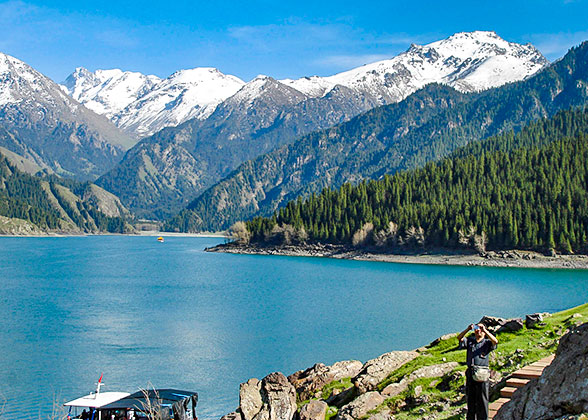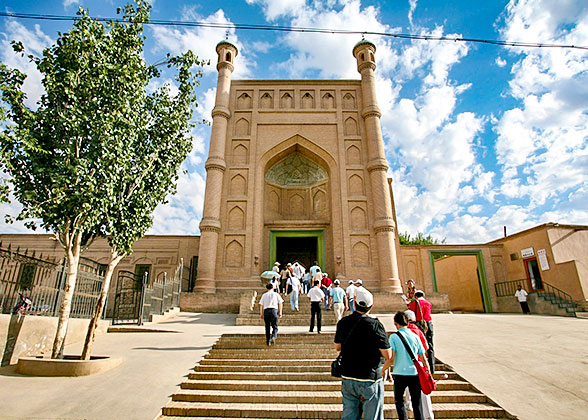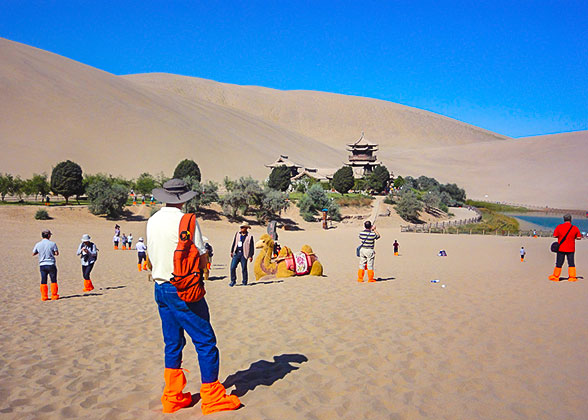Kashgar features a typical temperate continental arid climate, characterized by: four distinct seasons, significant annual and daily temperature variations; sparse precipitation throughout the year with dry air; and abundant sunshine.
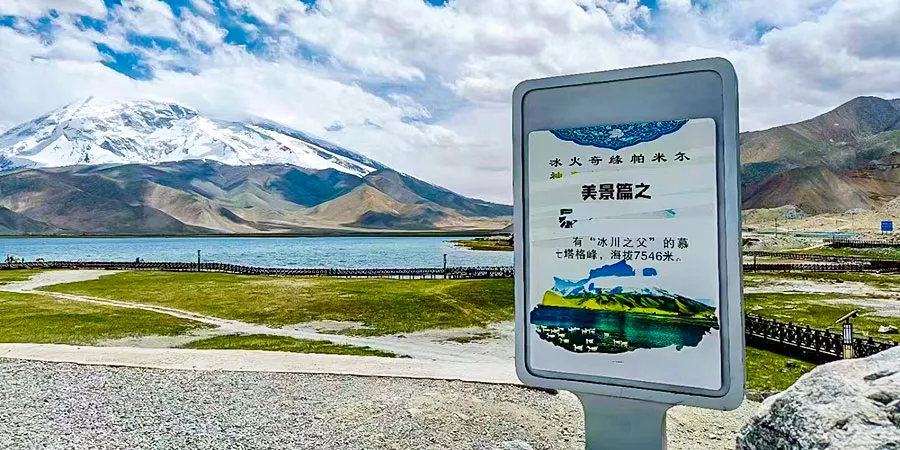 |
| View of the Pamir Plateau |
What Is the Temperature like in Kashgar?
Kashgar enjoys comfortable and mild springs from April to May and autumns from September to October, hot summers from June to August, and cold winters from November to March, indicating significant temperature fluctuations throughout the year. Specifically, take Kashgar as an example: throughout the year, its highest temperature can reach around 38 degrees Celsius (100 degrees Fahrenheit), while its lowest temperature can drop to around -15℃ (5°F). Daily temperature variations are also substantial, typically reaching 10-15℃ (18-27°F). This means you need to pack clothing of varying thicknesses regardless of your visit time.
Due to the complex topography that includes plains as well as mountains, valleys, and plateaus, the temperature varies among different areas. For example, Tashkurgan in the Pamir Plateau experiences temperature approximately 10℃ (18°F) lower than that of most areas like Kashgar City.
High/Low Temperatures of Kashgar
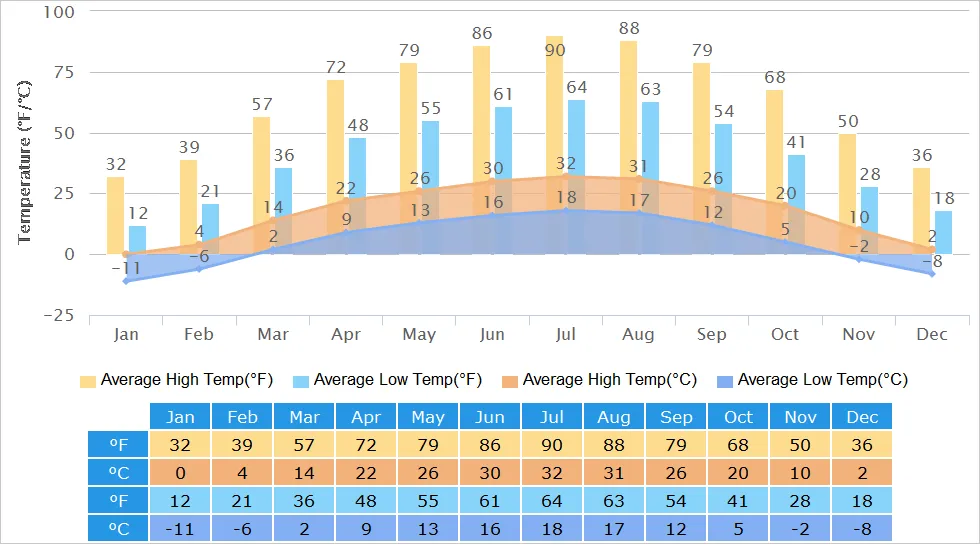
The Coldest Month
January is the coldest month in Kashgar. During this period, temperature in most areas such as Kashgar City and Shache ranges from -10 to 0℃ (14-32°F), with lows potentially dropping to around -15℃ (5°F). In higher-altitude regions like Tashkurgan, temperature may decrease to -20 to -5℃ (-4-23°F). Occasionally, the low drops to -30℃ (-22°F).
The Hottest Month
July marks the hottest period. Most areas experience intense heat. In Kashgar City, the temperatures typically range from 20-35℃ (68-95°F). In contrast, areas in the Pamir Plateau like Tashkurgan are relatively cool and comfortable, with the temperature of about 15-25℃ (59-77°F).
Rare Precipitation
Overall, precipitation throughout the year is low across all areas of Kashgar. On average, the monthly value does not exceed 20 mm, with some months even falling below 10 mm, and the average number of rainy days per month does not exceed 5. However, precipitation tends to be slightly higher in areas at higher elevations.
Does It Snow in Kashgar, China?
Yes, Kashgar sees snow in winter.
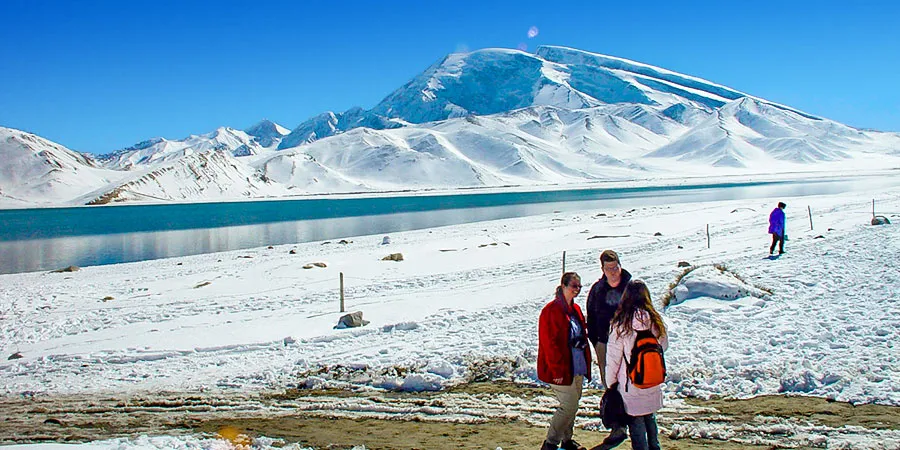 |
| Karakuri Lake Covered by Snow |
Low-altitude areas typically experience rainy days from March to early November, and snowy days from late November to February. In these areas, both rain and snow are small and not continuous, causing no disruption to travel. In high-altitude areas such as the Pamir Plateau and
Kunlun Mountains, however, the lower temperature results in snowy weather over a longer period, with moderate to heavy snow falling more frequently.
Average Rainfall of Kashgar
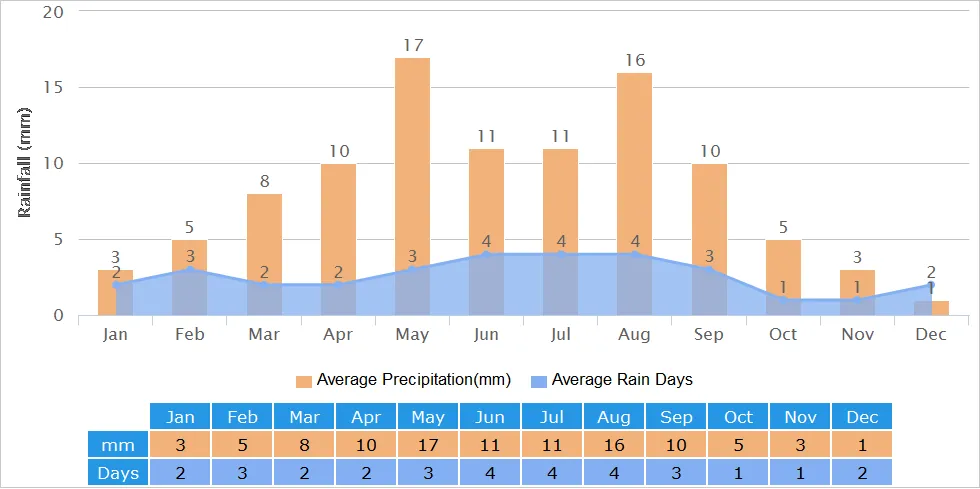
How Dry Is Kashgar?
In addition to quite low precipitation, Kashgar also experiences high evaporation rates, resulting in extremely dry conditions throughout the year. During summer, average humidity levels drop to just 30-40%. At this time, you are likely to feel parched when staying outdoors.
Humidity Graph of Kashgar
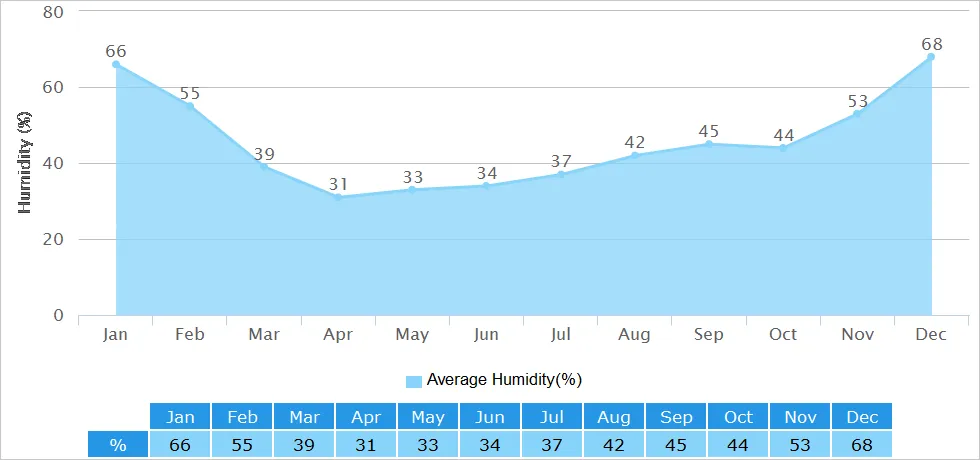
How Many Daylight/ Sunshine Hours Are There in Kashgar?
Kashgar experiences extremely long daylight hours in summer, averaging around 15, while winter days are exceptionally short, with the shortest day being only about 9 hours long.
The sunshine hours are long. Generally, summer boasts the longest sunshine hours, reaching approximately 9 to 10 hours per day. Even in winter, the region can receive about 5 sunshine hours per day on average. Combined with thin cloud cover, ultraviolet radiation is intense most time, making sun protection measures essential.
Spring from April to May and autumn from September to October are the best times to visit Kashgar. Then, what can you expect if you visit Kashgar during these periods in 2025?
If you travel to Kashgar from April to May, you will find that the weather of Kashgar is sunny and the daytime temperature is favorable for walking around in most areas. Besides, during this period, you have a chance to spot various flowers like apricot blossoms, peach blossoms, and almond blossoms.
Autumn provides you with similar weather conditions to spring. In terms of the natural scenery, there are no flowers at this time, but appealing golden poplar forests everywhere, which is a highlight of Kashgar region. In addition, fruits like grapes and melons ripen at this time.
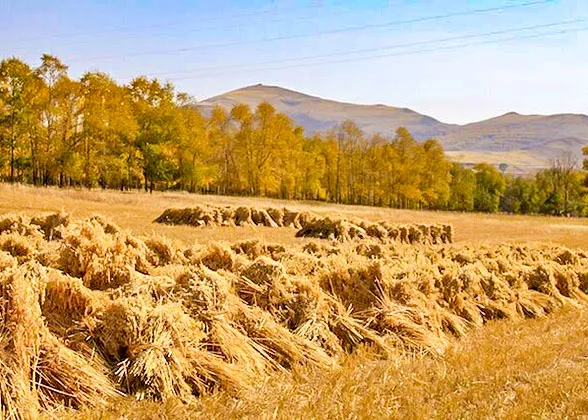 | | Golden Grassland in Autumn | | 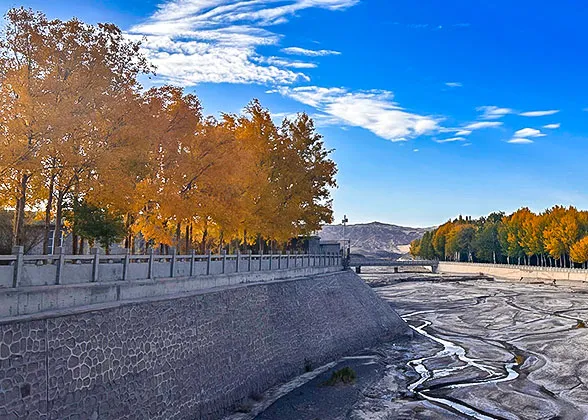 | | Beautiful Autumn Leaves | |
7-Day Kashgar Weather Forecast
CityWeather
Kashgar Climate - Seasons & Travel Recommendations
Spring: April - May
Spring in most areas of Kashgar is bright and comfortable. Taking Kashgar City as an example, it is cool at about 10-25℃ (50-77°F) in April and warm at 20-30℃ (68-86°F) in May. As for precipitation, there will only be several light spring showers. Sometimes, sandstorms and floating dust occur. Temperature in the Pamir Plateau tends to be cooler: Tashkurgan sees temperature ranging from around 0-15℃ (32-59°F) in April, and 5-20℃ (41-68°F) in May; mornings and evenings can be a bit chilly, but daytimes with sunshine are relatively warm.

What to Pack: sweatpants, short- and long-sleeved T-shirts, 3-in-1 jackets, hiking boots, masks

Travel Recommendations: You can stroll through
Kashgar Old Town under the warm sun to immerse yourself in Uyghur culture. Of course, you can also head to the Pamir Plateau to admire the pink sea of apricot blossoms and other magnificent natural landscapes, however, be sure to dress warmly to stay cozy.
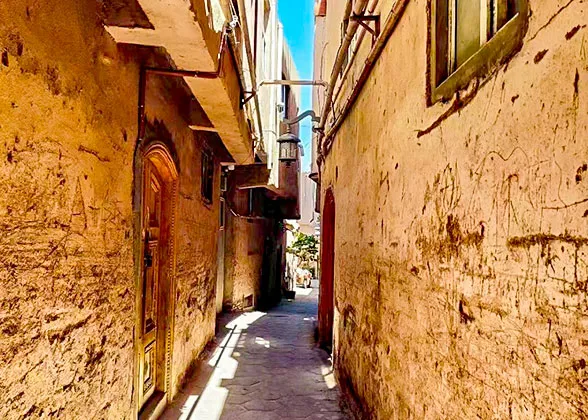 | | Kashgar Old Town | | 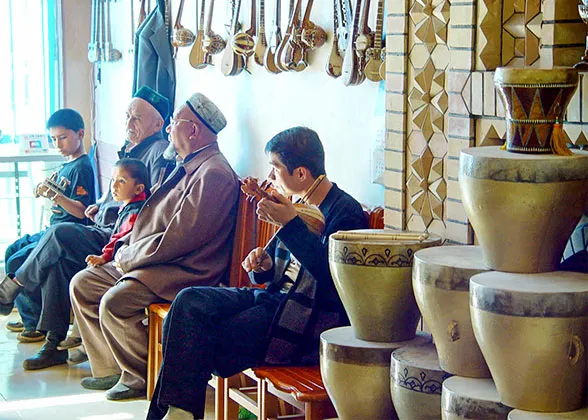 | | Local Store in Kashgar Old Town | |
Summer: June - August
For most areas of Kashgar, summer is hot and dry with many sunny days. The daily variation of temperature is quite significant. For instance, Kashgar City sees daily low temperature hovering around 20°C (68°F), and daily high of about 30-35°C (86-95°F). While the temperature may not seem exceptionally high, the long hours of sunshine and minimal cloud cover can make it feel quite scorching. The Pamir Plateau, however, has mild daytime temperature of 20-25°C (68-77°F).

What to Pack:
(1) T-shirts, thin pants, dresses for daytime, and trench coats and windbreakers for nighttime.
(2) Sunglasses, sunhats, and sunscreen.

Travel Recommendations and Tips: The Pamir Plateau, with comfortable temperature, is the ideal destination to escape the heat. Under bright sunshine in summer, the already lush green grasslands, clear and blue
Karakuri Lake, and majestic snow-capped mountains are even more stunning. It’s advisable to avoid visiting attractions in the lower-altitude urban areas like Kashgar Old Town during the hottest noon.
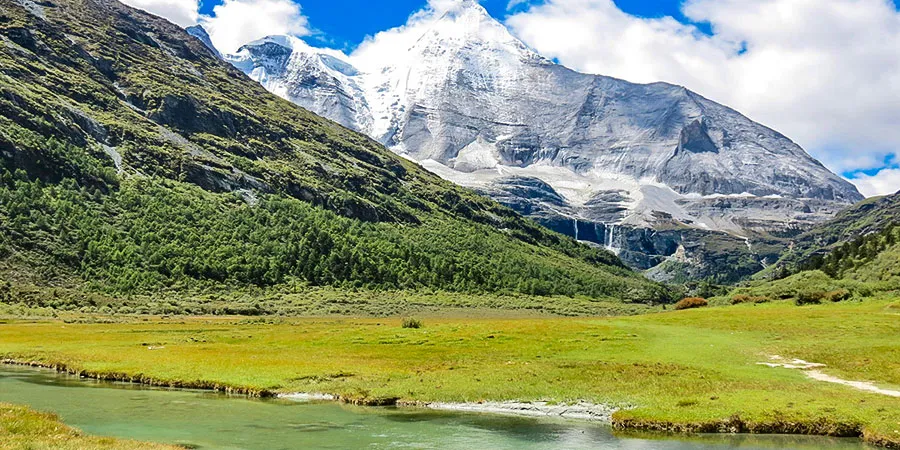 |
| Vibrant Grassland in Summer |
Autumn: September - October
In autumn, Kashgar climate is comfortable and suitable for travel. With the daily high dropping gradually from around 30°C (86°F) to 20°C (68°F), the daytime is warm at the beginning of September and cool at the end of October. As the temperature gap between day and night can reach about 10-15°C (18-27°F), you will feel a bit cold at night, especially in October. The two months are cold at 5-20°C (41-86°F) and 0-15°C (32-59°F) respectively in Tashkurgan of the Pamir Plateau. Precipitation is limited, with a little rain expected in most areas; but snow may fall on the Pamir Plateau.

What to Pack: long-sleeved T-shirts, sweaters, 3-in-1 jackets, down jackets, jeans, long johns, outdoor pants, hiking boots

Travel Recommendations and Tips: The luxuriant yellow poplar trees are the highlights of autumn in Kashgar, and Jinhu Yang National Forest Park with tens of thousands of acres of poplar forests is one of the famous destinations. In addition to the huge temperature difference in a day, you should also be told that the “
Golden Week” in early October is extremely crowded, especially in Kashgar Old Town.
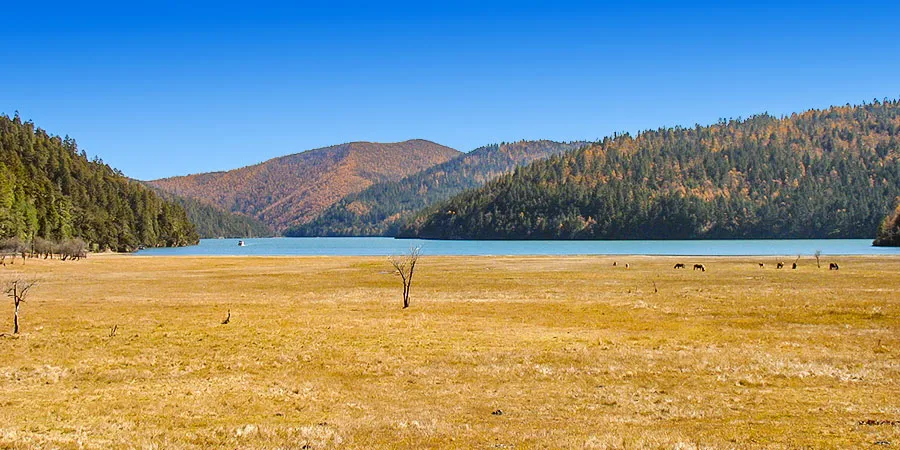 |
| Autumn View of the Pamir Plateau |
Winter: November - March
In November and March, the beginning and last months of the long winter, the temperature is not particularly low. For example, Kashgar City has highs reaching 10-20°C (50-68°F) and lows mostly staying above freezing in these two months. The coldest period spans from December to February, when daytime and nighttime temperature hovers between -5°C to 5°C (23-41°F) and -10°C to -5°C (14-23°F), respectively. Areas in the Pamir Plateau are cold throughout whole winter, with the temperature typically being 10-15°C (18-27°F) lower than in Kashgar City. This means the minimum temperature here can be as low as around -20°C (-4°F). Precipitation is rare and primarily falls as snow.

What to Pack: thermal shirts and pants, sweaters, outdoor pants, down coats, snow boots, scarves, and hats

Travel Recommendations and Tips: Kashgar in winter also offers many worthwhile destinations: White Sand Lake with crystal-clear ice, the even more majestic Muztagata Peak, the tranquil Kashgar Old Town, and the bustling
Kashgar Bazaar. However, if your trip is in the quite cold period from December to February, you are recommended to schedule outdoor activities between 12:00 and 19:00, when temperature is relatively higher. Additionally, the Panlong Ancient Road to Tashkurgan may be closed due to heavy snow. Be sure to check the latest conditions before traveling.
 Further Reading: Xinjiang Weather
Further Reading: Xinjiang Weather
- Last updated on Oct. 27, 2025 by Demi Li -
 January is the coldest month in Kashgar. During this period, temperature in most areas such as Kashgar City and Shache ranges from -10 to 0℃ (14-32°F), with lows potentially dropping to around -15℃ (5°F). In higher-altitude regions like Tashkurgan, temperature may decrease to -20 to -5℃ (-4-23°F). Occasionally, the low drops to -30℃ (-22°F).
January is the coldest month in Kashgar. During this period, temperature in most areas such as Kashgar City and Shache ranges from -10 to 0℃ (14-32°F), with lows potentially dropping to around -15℃ (5°F). In higher-altitude regions like Tashkurgan, temperature may decrease to -20 to -5℃ (-4-23°F). Occasionally, the low drops to -30℃ (-22°F). What to Pack: sweatpants, short- and long-sleeved T-shirts, 3-in-1 jackets, hiking boots, masks
What to Pack: sweatpants, short- and long-sleeved T-shirts, 3-in-1 jackets, hiking boots, masks Travel Recommendations: You can stroll through Kashgar Old Town under the warm sun to immerse yourself in Uyghur culture. Of course, you can also head to the Pamir Plateau to admire the pink sea of apricot blossoms and other magnificent natural landscapes, however, be sure to dress warmly to stay cozy.
Travel Recommendations: You can stroll through Kashgar Old Town under the warm sun to immerse yourself in Uyghur culture. Of course, you can also head to the Pamir Plateau to admire the pink sea of apricot blossoms and other magnificent natural landscapes, however, be sure to dress warmly to stay cozy. What to Pack:
What to Pack:  Travel Recommendations and Tips: The Pamir Plateau, with comfortable temperature, is the ideal destination to escape the heat. Under bright sunshine in summer, the already lush green grasslands, clear and blue Karakuri Lake, and majestic snow-capped mountains are even more stunning. It’s advisable to avoid visiting attractions in the lower-altitude urban areas like Kashgar Old Town during the hottest noon.
Travel Recommendations and Tips: The Pamir Plateau, with comfortable temperature, is the ideal destination to escape the heat. Under bright sunshine in summer, the already lush green grasslands, clear and blue Karakuri Lake, and majestic snow-capped mountains are even more stunning. It’s advisable to avoid visiting attractions in the lower-altitude urban areas like Kashgar Old Town during the hottest noon. What to Pack: long-sleeved T-shirts, sweaters, 3-in-1 jackets, down jackets, jeans, long johns, outdoor pants, hiking boots
What to Pack: long-sleeved T-shirts, sweaters, 3-in-1 jackets, down jackets, jeans, long johns, outdoor pants, hiking boots Travel Recommendations and Tips: The luxuriant yellow poplar trees are the highlights of autumn in Kashgar, and Jinhu Yang National Forest Park with tens of thousands of acres of poplar forests is one of the famous destinations. In addition to the huge temperature difference in a day, you should also be told that the “Golden Week” in early October is extremely crowded, especially in Kashgar Old Town.
Travel Recommendations and Tips: The luxuriant yellow poplar trees are the highlights of autumn in Kashgar, and Jinhu Yang National Forest Park with tens of thousands of acres of poplar forests is one of the famous destinations. In addition to the huge temperature difference in a day, you should also be told that the “Golden Week” in early October is extremely crowded, especially in Kashgar Old Town. What to Pack: thermal shirts and pants, sweaters, outdoor pants, down coats, snow boots, scarves, and hats
What to Pack: thermal shirts and pants, sweaters, outdoor pants, down coats, snow boots, scarves, and hats Travel Recommendations and Tips: Kashgar in winter also offers many worthwhile destinations: White Sand Lake with crystal-clear ice, the even more majestic Muztagata Peak, the tranquil Kashgar Old Town, and the bustling Kashgar Bazaar. However, if your trip is in the quite cold period from December to February, you are recommended to schedule outdoor activities between 12:00 and 19:00, when temperature is relatively higher. Additionally, the Panlong Ancient Road to Tashkurgan may be closed due to heavy snow. Be sure to check the latest conditions before traveling.
Travel Recommendations and Tips: Kashgar in winter also offers many worthwhile destinations: White Sand Lake with crystal-clear ice, the even more majestic Muztagata Peak, the tranquil Kashgar Old Town, and the bustling Kashgar Bazaar. However, if your trip is in the quite cold period from December to February, you are recommended to schedule outdoor activities between 12:00 and 19:00, when temperature is relatively higher. Additionally, the Panlong Ancient Road to Tashkurgan may be closed due to heavy snow. Be sure to check the latest conditions before traveling. Further Reading: Xinjiang Weather
Further Reading: Xinjiang Weather











